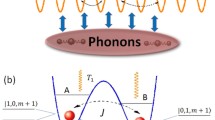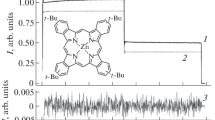Abstract
Within the model of stepwise relaxation of electronic excitation energy (the
model), we analyze the features of the luminescent spectral characteristics of aromatic and heteroaromatic molecules.We have shown that in order to satisfactorily explain the experimental data, we need to use a special case of the
model, the -
mechanism. We discuss the conditions under which the VaviIov rule and the Kasha and 8rmolaev-Sveshnikova rules are satisfied.
Similar content being viewed by others
Literature cited
V. A. Godik, “The orbital configuration of electronically excited states and the luminescent spectral properties of heteroaromatic molecules,” Dissertation in competition for the academic degree of Candidate of the Physical and Mathematical Sciences, Moscow (1981).
V. A. Godik, M. A. Pak, A. N. Rodionov, and D. N. Shigorin, “Intersystem conversion in polyatomic molecules. 3.,” Zh. Fiz. Khim.,59, No. 11, 2755–2759 (1985).
K. L. Rogoshin, A. N. Rodionov, S. G. Smirnov et al., “Electronic spectra and structure of aromatic derivatives of Group IVB and VB elements,” Izv. Akad. Nauk SSSR, Ser. Khim. No. 1, 338–342 (1976).
S. N. Davydov, V. A. Godik, A. N. Rodionov et al., “Some characteristics of deactivation of electronically excited states of heteroaromatic derivatives of the fluorene series,” Zh. Fiz. Khim.,58, No. 10, 2499–2502 (1984).
R. N. Nurmukhametov and V. G. PIotnikov, “Radiationless transitions and luminescence of molecules of aromatic hydrocarbons,” Izv. Akad. Nauk SSSR, Ser. Fiz.,39, No. 11, 2259–2263 (1975).
M. Blume and R. E. Watson, “Theory of spin-orbit coupling in atoms. 2. Comparison of theory with experiment,” Proc. Soc. London A,271, No. 1219, 565–578 (1963).
D. S. McClure, “Spin-orbit interaction in aromatic molecules,” J. Chem. Phys.,20, No. 4, 682–686 (1952).
L. Goodman and R. W. Harrell, “Calculation of 25-4 transition energies in N-heterocycIic molecules by a one-electron approximation,” J. Chem. Phys.,30, No. 5, 1131–1138 (1959).
V. A. Godik, V. K. Potapov, A. N. Rodionov, and D. N. Shigorin, “Configuration of the highest occupied molecular orbital, the first ionization potential, and the electronic structure of hetezoaromatlc molecules,” Teor. Éksp. Khim.,20, No. 1, 373–376 (1984).
V. A. Godik, G. G. Konoplev, A. N. Rodionov, and D. N. Shigorin, “Structure of matrices for the change in electron density, an interaction, and the orbital configuration of excited states of complex heteroaromatic molecules,” Zh. Fiz. Khim.,59, No. 8, 1966–1969 (1985).
V. A. Godik, A. N. Rodionov, and D. N. Shigorin, “The structure of matrices for the change in electron density and the orbital configuration of the excited states for complex heteroaromatic molecules,” Zh. Fiz. Khim.,59, No. 9, 240–2246 (1985).
V. A. Godik, S. N. Davydov, G. G. Konoplev et al”, “Quantum chemical study of the triplet states of fluorene, carbazole, and dibenzofuran.” Teor. Éksp. Khim.,18, No. 3, 323–327 (1982).
J. -M. Bonnier, P. Jardon, and J. -P. Blanchi, “Fluorescence of isologs of dibenzofuran at energy transfer to phenylthienyl-3-ketone,” Bull. Soc. Chim. France, No. 12, 4787–4790 (1968).
V. L. Ermolaev and E. B. Sveshnikova, “Application of triplet-singlet transfer to the study of internal degrdation of electronic energy in organic molecules,” Optika i Spektroskopiya,16, No. 4, 587–593 (1964).
M. Kasha, “Characterization of electron transition in complex molecules,” Faraday Disc. Chem. Soc.,9, No. l, 14–19 (1950).
V. V. Ryl'kov and D. A. Cheshev, “Singlet -triplet interconversion in upper states of xanthene dyes,” in: Abstracts, All-Union Conference on Organic Luminophores and Their Application in the National Economy, Khar'kov December 5-7, 1984 [in Russian], Khar'kov (1984), p. 140.
Additional information
L. Ya. Karpov Scientific-Research Physical Chemistry Institute, Moscow. Translated from Teoreticheskaya i Éksperimental'naya Khimiya, Vol. 27, No. 1, pp. 22–28, January, 1991. Original article submitted March 9, 1987.
Rights and permissions
About this article
Cite this article
Godik, V.A., Rodinov, A.N. & Shigorin, D.N. Intersystem conversions in polyatomic molecules within the model of stepwise relaxation of electronic recitation energy. Theor Exp Chem 27, 20–25 (1991). https://doi.org/10.1007/BF01372918
Issue Date:
DOI: https://doi.org/10.1007/BF01372918




